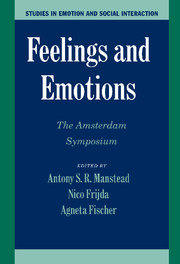Book contents
- Frontmatter
- Contents
- List of Contributors
- 1 Introduction
- PART I THE NATURE OF FEELINGS AND EMOTIONS
- PART II BASIC PSYCHOLOGICAL PROCESSES IN FEELINGS AND EMOTIONS
- PART III FEELINGS AND EMOTIONS: THE PLACE OF PLEASURE
- PART IV FEELINGS AND EMOTIONS IN THEIR SOCIOCULTURAL CONTEXT
- PART V FEELINGS, EMOTIONS, AND MORALITY
- 22 On the Possibility of Animal Empathy
- 23 Emotional Gifts and “You First” Micropolitics
- 24 Introducing Moral Emotions into Models of Rational Choice
- 25 Virtue and Emotional Demeanor
- 26 Epilogue
- Subject Index
- Author Index
- Plate section
- References
23 - Emotional Gifts and “You First” Micropolitics
Niceness in the Socioemotional Economy
Published online by Cambridge University Press: 05 June 2012
- Frontmatter
- Contents
- List of Contributors
- 1 Introduction
- PART I THE NATURE OF FEELINGS AND EMOTIONS
- PART II BASIC PSYCHOLOGICAL PROCESSES IN FEELINGS AND EMOTIONS
- PART III FEELINGS AND EMOTIONS: THE PLACE OF PLEASURE
- PART IV FEELINGS AND EMOTIONS IN THEIR SOCIOCULTURAL CONTEXT
- PART V FEELINGS, EMOTIONS, AND MORALITY
- 22 On the Possibility of Animal Empathy
- 23 Emotional Gifts and “You First” Micropolitics
- 24 Introducing Moral Emotions into Models of Rational Choice
- 25 Virtue and Emotional Demeanor
- 26 Epilogue
- Subject Index
- Author Index
- Plate section
- References
Summary
ABSTRACT
Patterned exchanges of emotions in everyday life help build walls of indifference or enmity and webs of affiliation. Interview and observational data show that the “nice” person and the “micro-hero” give emotional gifts and use a variety of “you first” strategies to safeguard others' emotions and micropolitical places.
INTRODUCTION
Whether people are aware of it or not, human emotionality is an ongoing stream, and what Westerners refer to as emotions – the bits of experience from this stream that a given culture has recognized, labeled, and scripted – pervade every aspect of social life. As more recent evidence bears out (see, e.g., Sally, 2000, p. 579; Scheff, 1990; Wentworth & Ryan, 1992; Wentworth & Yardley, 1994; and Zajonc, 1998), the words that Hume wrote in 1740 were quite apt: “no object is presented to the senses, nor image form'd in the fancy, but what is accompany'd with some emotion or movement of spirits proportion'd to it … however custom may make us insensible of this sensation, and cause us to confound it with the object or idea …” ([1740] 1978, p. 373). If we think about it, we realize that even seemingly routine cognitive and physical tasks such as reading a term paper, balancing the checkbook, glancing at a stranger walking down the street, or doing laundry are accompanied by emotions, be they strong or weak. If our attention is caught in the action, our emotions concern it; if our attention wanders from the task, our emotions stray elsewhere.
- Type
- Chapter
- Information
- Feelings and EmotionsThe Amsterdam Symposium, pp. 402 - 421Publisher: Cambridge University PressPrint publication year: 2004
References
- 6
- Cited by

